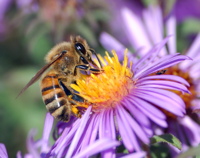Multifactorial Synergy

Recently, a doctor friend told me about something called multifactorial synergy. As herbalists know, you can’t simply isolate one compound or another and expect the resulting extract to have the same medicinal properties as the whole herb. Plants are more complicated than that. It occurred to me that this also describes the landscape. Plants respond to the complex environment in which they find themselves. That environment includes soil, weather, the seasons, other plants nearby, pollinators, and people. It’s an interwoven, interactive system. It’s multifactorial synergy.
When we choose what to plant around our homes, we have an opportunity to participate in that complex system. We can cultivate the monoculture lawn and the monoculture garden and orchard if we choose. Or we can take another tack. We can plant a diversity of species. We can throw out labels like “ornamental” and think instead about interactions and collaborations. Perhaps the raspberries go next to the house and the grapes climb up the porch. Maybe the roses and sunflowers go out in the orchard near the apple trees. Maybe the peach trees grow on the side of the living room facing south. Ours love it there.
Much of the landscape we see is contrived by people. We’re part of the synergy! Fortunately, plants and people love each other’s company. Without us, a lot of them wouldn’t be here. Without them, none of us would be here. Espalier is an extreme form of human-plant interaction. See our pollination page for a very different kind of collaboration. Plant thoughtfully and then stand back and trust the pollinators to do their thing.
This has been the strategy in our functional orchard at home. It’s also
how we’re cultivating the Maine Heritage Orchard in Unity at the Maine
Organic Farmers and Gardeners Association (MOFGA) education center. In a
renovated gravel pit, we are preserving hundreds of historic apple varieties
and growing them as part of an incredibly diverse polyculture. When people
ask us how we get apple trees to grow in an abandoned wasteland, I reply,
“Multifactorial synergy.”
—John Bunker
Wild Hugel Ditch
Down the center of my beautiful 10-acre field is a 250' long, 3' deep, 4' wide ditch, dug years ago for electrical conduit. In the fall when I first moved onto the land, the trench looked pretty ugly to me: rough with boulders and piles of soil all over the place, covered in grass, weeds and chokecherries. I looked forward to someday having the time and equipment to fill it in. In the meantime, I started filling it with all the random woody debris that I didn’t have a good place for. How convenient, I thought—just throw it in the ditch!
Summer rolls around and the trench is blooming with purple-blue vetch, bright yellow St. Johnswort, different species of goldenrod, milkweed, rudbeckia and meadowsweet. One day I stopped glaring at it long enough to think, “Wait a second, it’s beautiful!” Not only that but it’s a pollinator haven, the flowers buzzing with bees. The chokecherries are abundantly ripening and soon I’ll make jelly or wine.
At some point it occurred to me what was happening—ditch-style hugelculture. When the ditch gets filled to the top with stumps, rootballs and other woody debris not suitable for the compost or burn pile, I toss on large clumps of perennials like daylily, phlox, boneset and blue vervain. I’m not even digging holes, just piling more scruffy debris and compost around the plants, which will eventually break down. These are not the fragile members of the perennial garden; they are the tough ones that are hard to kill. The more I toss in the ditch, the more diverse the wild hedge gets.
My ditch hugelculture is so much less time, work and expense than trying to
remove the trench, and the fox dens and bird nests built there have been
spared from destruction. What I once saw as an eyesore is now a thriving
colorful hugelculture hedge alive with insects and animals.
–Lauren Cormier
Hedgerows Provide:
forage for birds, bees, butterflies, hummingbirds, moths, beneficial insects and humans
protection for nesting birds and migratory animals
erosion control and water conservation
privacy screens, windbreaks, mazes or secret gardens
texture, aroma, character and color in a cultivated landscape
renewable material for kindling, crafts, bouquets and wood chips
